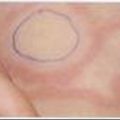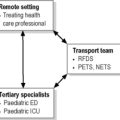3.1 Introduction to paediatric trauma
Prevention
Over the last decades, Australia has done well in reducing the death rate from approximately 11.5 deaths per hundred thousand to about 8.5 (World Health Organization).1 However, while the death rate has been almost halved, it is still double that of some of the best OECD countries. Most developed countries have significantly reduced injury death rates. Unfortunately this is not the case in developing countries. While we have achieved much through prevention strategies, there is still more to be done.
Succinct treatment (salvage)
Hospitals now have trauma teams ready to receive the child. This may occur by forward notification by the emergency management services. Trauma team activation should occur on notification when a child is at high risk of life-threatening injury according to prediction by pre-determined clinical and mechanism parameters (Table 3.1.1).
Death of same-car occupant
Pedestrian/cyclist struck at >30 kph
MVA, motor vehicle accident.
Source: Adapted from Cameron P. 2004. Textbook of Adult Emergency Medicine, 2nd edn.
Regular trauma meetings to review cases or videotape evaluation of resuscitation can provide education, with lessons learnt on ‘how to do things better’. As major paediatric trauma is relatively uncommon, mock paediatric resuscitation scenarios can provide the emergency department staff with an opportunity to improve preparedness. There is now a good body of international literature available to keep the trauma team up to date with the optimal care of paediatric trauma patients. The use of a trauma proforma sheet may be useful for the documentation of the assessment and resuscitation of children with major injuries (see Table 3.1.1).
The best way to remember the acute management of trauma in children is to remember the a, b, c, d, e as lower case. That is, the sequence is exactly the same as in adults but there are additional nuances in children to optimise their care. However, more children suffer or die in the acute management of trauma by clinicians panicking and not following the A, B, C, D, E approach rather than doctors not being completely familiar with these nuances (see primary survey below). Delayed management of airway obstruction or inadequate fluid management are the two most common contributors to preventable paediatric deaths in trauma. Chapters 2.2 and 2.3 provide a detailed discussion of basic life support and advanced life support (ALS) techniques in children applicable in trauma.
Paediatric differences
A Airway and cervical spine control
In the setting of trauma, ‘A’ refers to securing of the child’s airway with concurrent attention to the possibility of an unstable cervical injury. The cervical spine should be immobilised using an appropriate-sized hard collar, sandbags, tape and a spinal board where appropriate. It may be helpful in an infant to place a small towel under the space in the shoulder region caused by ‘the elevation off the bed’ by the prominent occiput at this age. As discussed in the ALS section in Chapter 2.3, the characteristics of the paediatric airway make it more vulnerable to obstruction. This can be exacerbated by the necessary supine positioning of the child on the resuscitation trolley. Due to comparatively higher oxygen demands and less reserve, a child manifests hypoxic decompensation earlier than adults. This reinforces the increased importance of airway management in achieving adequate ventilation. The initial airway-opening manoeuvre in trauma patients should be by the jaw thrust technique to maintain cervical spine immobilisation. Suctioning of any oropharyngeal soiling from blood, vomit, teeth or other foreign bodies may be necessary. Adjuncts such as the placement of an oropharyngeal airway may be required. In children, these should be placed into the oral cavity directly, using gentle depression of the tongue with a spatula to allow for atraumatic positioning. Nasopharyngeal airways are not recommended due to the potential presence of cribriform plate fractures, and trauma to the turbinates may cause bleeding that may further complicate airway patency.
The technique of intubation should be rapid sequence with cricoid pressure. The control of the cervical spine during intubation should occur by manual immobilisation by a dedicated assistant. The patient should have continuous monitoring, pre-oxygenation and difficult airway adjuncts available, if required. The choice and dosage of the sedation agent (thiopentone, midazolam, propofol, or fentanyl, for example) may be individualised according to factors such as the level of coma, cardiovascular status of the child and the presence of other injuries. A rapidly and short acting muscle relaxant such as suxamethonium usually provides the most optimal intubation conditions, despite the potential for transient increase in intracranial and intraocular pressures with fasciculation. Children less than 2 years of age are prone to significant bradycardia on laryngoscopy, which may be blunted by the administration of atropine, prior to intubation. Confirmation of correct ETT placement should occur according to the methods described in Chapter 2.3. One needs to be prepared for the possibility of the difficult airway or failed intubation and have a planned algorithm to deal with this possibility. It is not the failed intubation that causes the problem, but the lack of a plan of action to alternatively oxygenate the patient in this situation, whilst summoning assistance.
B Breathing and high-flow oxygen
All children with severe trauma should receive high-flow oxygen (10–15 L min–1) by a reservoir face mask, independent of the need determined by saturation monitoring. Inadequate spontaneous ventilation is supported by bag and mask assistance. If this need is ongoing, intubation is required. A rapid screen for life threats, such as a tension pneumothorax, should occur. This may require immediate decompression by needle aspiration for the child in extremis and a subsequent formal chest drain, as described in the section on chest trauma (see chapter 3.3). The possibility of developing tension due to a pneumothorax should be borne in mind as one of the potential precipitants of rapid deterioration following the initiation of positive pressure ventilation.
C Circulation and stop haemorrhage
The child with major trauma requires urgent intravenous access with the largest practical cannulae into visible or palpable peripheral veins. In the shocked child, cephalic, femoral or great saphenous veins are usually the most accessible. Where vascular cannulation is unsuccessful, after 60–90 seconds, the child who requires immediate fluids or drugs to facilitate intubation, should have a rapid intraosseous needle placed as described in Chapter 23.11. This is clearly the second line method that should be used in children without hesitation, rather than cutdown techniques that may be applicable in adults. In certain circumstances, such as the small child backed over by a motor vehicle with obvious major abdominal, pelvic or lower limb trauma, it may be prudent to use additional alternative access into a vein that drains into the SVC (e.g. external jugular or subclavian). In this rare situation, lower limb intraosseous infused volume may not access the circulation effectively due to disruption of the normal continuity of the intraosseous and intravascular spaces.
D Disability
The most rapid way to assess a child’s conscious level in the primary survey is by using the AVPU scale (see Table 3.2.2).
Other issues during initial stabilisation
Secondary survey
 Head to toe, front and back examination – the child should have a methodical and thorough clinical examination to identify all injuries. The head, face, neck, chest, abdomen, pelvis, spine and extremities (see orthopaedic trauma below) need to be examined. A more formal neurological assessment should use a paediatric GCS. The spinal immobilisation needs to be maintained until clinical or radiological clearance, in cases where this is possible. During this phase, placement of an orogastric tube may occur if gastric decompression is indicated. A urinary catheter (with the standard precautions for a potential urethral injury) is indicated in the unconscious child or where the accurate measurement of urine flow is required.
Head to toe, front and back examination – the child should have a methodical and thorough clinical examination to identify all injuries. The head, face, neck, chest, abdomen, pelvis, spine and extremities (see orthopaedic trauma below) need to be examined. A more formal neurological assessment should use a paediatric GCS. The spinal immobilisation needs to be maintained until clinical or radiological clearance, in cases where this is possible. During this phase, placement of an orogastric tube may occur if gastric decompression is indicated. A urinary catheter (with the standard precautions for a potential urethral injury) is indicated in the unconscious child or where the accurate measurement of urine flow is required. Investigations – appropriate bloods should be sent on initial intravenous access, along with a bedside glucose measurement. In the multiply injured child, initial radiological films should potentially include a resuscitation room chest X-ray, lateral cervical spine and pelvis. A 12-lead ECG should be done where a child has sustained significant trauma to the chest.
Investigations – appropriate bloods should be sent on initial intravenous access, along with a bedside glucose measurement. In the multiply injured child, initial radiological films should potentially include a resuscitation room chest X-ray, lateral cervical spine and pelvis. A 12-lead ECG should be done where a child has sustained significant trauma to the chest.Orthopaedic trauma
A discussion of specific injuries and their management is dealt with in detail in Section 24.





